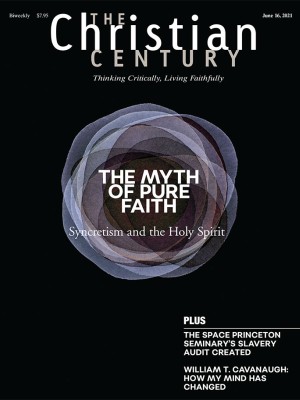
In the early weeks of the pandemic in New York City, when ambulance sirens were our soundtrack and we skipped daily walks because of the morgue trucks parked a few blocks away, family movie night on Sundays was often the only thing that structured a long, monotonous day at the end of a long, monotonous week. For the first few months we found ample outlet for our various emotional states; we wept our way through Inside Out and laughed uproariously at Paddington 2. But as the year wore on and we found ourselves dredging the back catalogs for Rio 2, the magic was giving way to a monotony of its own.
Imagine my delight, then, when this spring a new crop of family movies hit our streaming services, giving new life to our Sunday ritual. Flora and Ulysses (directed by Lena Khan, streaming on Disney+), Finding ‘Ohana (directed by Jude Weng, streaming on Netflix), and The Mitchells vs. the Machines (directed by Michael Rianda and Jeff Rowe, also on Netflix) were all widely enjoyed by all four members of our family (no small feat in itself). And all three illuminate the family movie formula: heroic adventure leads to renewed understanding of the family itself as a site of radical love and transformation.
Read our latest issue or browse back issues.
After 14 months of sustained research, I’ve come to realize there is a difference between a kid’s movie and a family movie. A kid’s movie is something a kid can watch all by herself, even in excerpted scenes divorced from the plot as a whole—think Moana or the Frozen movies. The best of the genre recognize that adults may be along for the ride and build in plenty of wry humor and poignant themes. A kid’s movie can often make a perfectly lovely choice for family movie night.
But family movies are a smaller subset of the kid’s movie genre. While they are still aimed at kids and their adults, they make the family itself the main subject of exploration. Usually a quirky member of the family (the “outsider”) drags the rest of the clan into a series of wild adventures that force the family to think explicitly about what makes them a family.
Flora (Matilda Lawler), for example, from Flora and Ulysses, is a verbally precocious ten-year-old cynic, who, in the wake of her parents’ divorce, has already decided life is meaningless. Misunderstood by most people around her, she imagines the world populated by comic book characters her father created. She is, therefore, uniquely prepared to meet Ulysses, a squirrel accidentally imbued with superhero powers. As she and her parents try to save Ulysses from an overzealous animal control agent, they are forced to reckon with the fears and insecurities that threaten their family harmony. Her parents, both frustrated artists, have to see past their own self-doubt and open themselves to risk and change. In return, Flora learns that risk and change are necessary for hope, and hope is the key to the life and love she thought was meaningless.
In Finding ‘Ohana, Pili (Kea Peahu) hides a nerdy passion for geocaching under her Brooklyn street attitude. When her single mother drags Pili and her brother to visit their grandfather in Hawaii, Pili discovers an old pirate map that promises a treasure that just might save her ancestral home. She drags her brother and two other kids on an outlandish quest that follows the major beats of the 1980s film The Goonies, complete with booby traps and pirate curses (but thankfully without the original’s racist stereotypes, misogyny, or open mockery of characters with disabilities).
While Pili and her brother are deciphering pirate clues, their mother is on her own quest to reconcile with her father and her grief. By the time they all come out the other side, they realize the treasure they are really seeking is ‘ohana, the Hawaiian word for home, belonging, or family.
In the animated film The Mitchells vs. the Machines, teenage daughter Kate (voiced by Abbi Jacobson) has always felt misunderstood by her father (voiced by Danny McBride), who thinks she’s wasting her life making YouTube videos instead of “real things” you can build with your hands. But when smartphones take over the world during their road trip to drop Kate off at film school, the Mitchells have to rely on their different strengths to battle the machines that threaten humanity. So too Kate and her dad have to learn to see how much they are shaped by their mutual entanglement. Family isn’t just a bunch of weirdos you try to escape, Kate realizes. If you are lucky, family are “your people,” and they make you the awesome weirdo you always wanted to be.
This is the fragile hope of the family movie: that families can be webs of love that expand to hold us through our fears, insecurities, self-discovery, and joy. The fear, of course, is that they are also traps of misunderstanding and false expectations: parents who narcissistically project their disappointments on their kids, kids who shut down in angry defiance.
A year into the pandemic, these fears and hopes feel especially poignant. For many of us, the family has been our main (or only) source of emotional and social connection. My family, at least, has been profoundly aware that the nuclear family alone is not enough. We need structural supports from our society, like schools and child care. We need communal networks of friends and neighbors and strangers at playgrounds to practice our human skills with so we can come back to the home with joys to share or wounds to tend.
But maybe this is why these family movies require superhero squirrels, pirate curses, or machine apocalypses to launch a quest of discovery: something has to break the ordinary slog of family life to help us see its potential for radical love, forgiveness, growth, and healing. A global pandemic certainly hasn’t felt like a glamorous adventure quest, but thanks in part to family movie night, it has definitely been a journey to better understand what the family can be.







